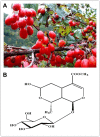Morroniside, a secoiridoid glycoside from Cornus officinalis, attenuates neuropathic pain by activation of spinal glucagon-like peptide-1 receptors
- PMID: 28098360
- PMCID: PMC5345663
- DOI: 10.1111/bph.13720
Morroniside, a secoiridoid glycoside from Cornus officinalis, attenuates neuropathic pain by activation of spinal glucagon-like peptide-1 receptors
Abstract
Background and purpose: Iridoid glycosides containing the double bond scaffold of cyclopentapyran are reversible and orthosteric agonists of glucagon-like peptide-1 (GLP-1) receptors and exert anti-nociceptive and neuroprotective actions. Morroniside, derived from the medicinal herb Cornus officinalis, is an atypical secoiridoid containing a six-membered cyclic inner ether fragment. Here we investigated whether morroniside was an orthosteric GLP-1 receptor agonist and had anti-hypersensitivity activities in a model of neuropathic pain.
Experimental approach: We used a model of neuropathic pain, induced by tight ligation of L5/L6 spinal nerves in rats. Hydrogen peroxide-induced oxidative damage was also assayed in N9 microglial cells and human HEK293 cells stably expressing GLP-1 receptors.
Key results: Morroniside protected against hydrogen peroxide-induced oxidative damage in N9 microglial and HEK293 cells that expressed mouse or human GLP-1 receptors, but not in HEK293T cells without GLP-1 receptors. The GLP-1 receptor orthosteric antagonist exendin(9-39) also concentration-dependently shifted the concentration-protective response curves of morroniside and exenatide to the right without affecting maximal protection, with similar pA2 values. Furthermore, morroniside given by oral gavage or intrathecally in neuropathic rats dose-dependently attenuated mechanical allodynia, with comparable Emax values and ED50 s of 335 mg·kg-1 and 7.1 μg and completely blocked thermal hyperalgesia. Daily intrathecal injections of morroniside over 7 days did not induce anti-allodynic tolerance. Pretreatment with intrathecal exendin(9-39) completely blocked systemic and intrathecal morroniside-induced mechanical anti-allodynia.
Conclusion and implications: Our data demonstrated that morroniside was an orthosteric agonist of GLP-1 receptors and produced antihypersensitivity in a neuropathic pain model by activation of spinal GLP-1 receptors.
© 2017 The British Pharmacological Society.
Figures





Similar articles
-
The GLP-1 receptor herbal agonist morroniside attenuates neuropathic pain via spinal microglial expression of IL-10 and β-endorphin.Biochem Biophys Res Commun. 2020 Sep 24;530(3):494-499. doi: 10.1016/j.bbrc.2020.05.080. Epub 2020 Jun 25. Biochem Biophys Res Commun. 2020. PMID: 32595037
-
Geniposide and its iridoid analogs exhibit antinociception by acting at the spinal GLP-1 receptors.Neuropharmacology. 2014 Sep;84:31-45. doi: 10.1016/j.neuropharm.2014.04.007. Epub 2014 Apr 18. Neuropharmacology. 2014. PMID: 24747181
-
Shanzhiside methylester, the principle effective iridoid glycoside from the analgesic herb Lamiophlomis rotata, reduces neuropathic pain by stimulating spinal microglial β-endorphin expression.Neuropharmacology. 2016 Feb;101:98-109. doi: 10.1016/j.neuropharm.2015.09.010. Epub 2015 Sep 9. Neuropharmacology. 2016. PMID: 26363192
-
Bioactivities of morroniside: A comprehensive review of pharmacological properties and molecular mechanisms.Fitoterapia. 2024 Jun;175:105896. doi: 10.1016/j.fitote.2024.105896. Epub 2024 Mar 11. Fitoterapia. 2024. PMID: 38471574 Review.
-
Glycosides for Peripheral Neuropathic Pain: A Potential Medicinal Components.Molecules. 2021 Dec 31;27(1):255. doi: 10.3390/molecules27010255. Molecules. 2021. PMID: 35011486 Free PMC article. Review.
Cited by
-
Glucagon-like peptide-1 (GLP-1) receptor agonists for headache and pain disorders: a systematic review.J Headache Pain. 2024 Jul 12;25(1):112. doi: 10.1186/s10194-024-01821-3. J Headache Pain. 2024. PMID: 38997662 Free PMC article.
-
Antiosteoarthritic Effect of Morroniside in Chondrocyte Inflammation and Destabilization of Medial Meniscus-Induced Mouse Model.Int J Mol Sci. 2021 Mar 15;22(6):2987. doi: 10.3390/ijms22062987. Int J Mol Sci. 2021. PMID: 33804203 Free PMC article.
-
Development of Syringaldehyde as an Agonist of the GLP-1 Receptor to Alleviate Diabetic Disorders in Animal Models.Pharmaceuticals (Basel). 2024 Apr 22;17(4):538. doi: 10.3390/ph17040538. Pharmaceuticals (Basel). 2024. PMID: 38675498 Free PMC article.
-
Microglial M2 Polarization Mediated the Neuroprotective Effect of Morroniside in Transient MCAO-Induced Mice.Front Pharmacol. 2021 Nov 19;12:784329. doi: 10.3389/fphar.2021.784329. eCollection 2021. Front Pharmacol. 2021. PMID: 34867417 Free PMC article.
-
Potential Role of Phytochemicals as Glucagon-like Peptide 1 Receptor (GLP-1R) Agonists in the Treatment of Diabetes Mellitus.Pharmaceuticals (Basel). 2024 Jun 5;17(6):736. doi: 10.3390/ph17060736. Pharmaceuticals (Basel). 2024. PMID: 38931402 Free PMC article. Review.
References
-
- Ai HX, Wang W, Sun FL, Huang WT, An Y, Li L (2008). Morroniside inhibits H2O2‐induced apoptosis in cultured nerve cells. Zhongguo Zhong Yao Za Zhi 33: 2109–2112. - PubMed
-
- Baggio LL, Drucker DJ (2007). Biology of incretins: GLP‐1 and GIP. Gastroenterology 132: 2131–2157. - PubMed
-
- Collett BJ (1998). Opioid tolerance: the clinical perspective. Br J Anaesth 81: 58–68. - PubMed
Publication types
MeSH terms
Substances
LinkOut - more resources
Full Text Sources
Other Literature Sources

